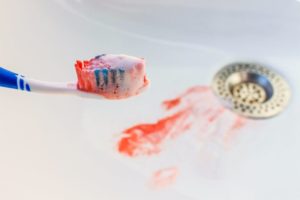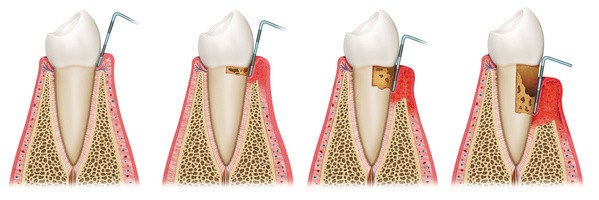Periodontics
Periodontology – what is it?

Periodontology – indications and contraindications
Indications
Contraindications
All patients with malocclusion in each plane are eligible for orthodontic treatment (overshot or undershot bite, wry mouth, crossbite, overbite, open bite, deep bite) and tooth defects (crowding, rotations, displacement, etc.). Orthodontists also deal with complex cases, e.g. patients with congenital malformations, with numerous orthodontic problems.
Specific indications for orthodontic and surgical treatment are teeth impacted in the bones (see: dental surgery). An orthodontist can also cooperate with a periodontologist, mainly in treatment of crowding, which often causes poor hygiene and periodontal disease.
Orthodontic treatment for children usually begins shortly before entering puberty peak to use bone growth for rapid tooth movement. Earlier treatment usually does not bring significant effects. Exceptions are complex defects, for which individualized multi-disciplinary care is indicated. An important, though relative, contraindication to the installation of the apparatus is incorrect oral hygiene, because the orthodontic braces predispose to accumulate plaque, which may cause caries and gingivitis. Orthodontic treatment is also contraindicated in the presence of unstable periodontitis, especially when the teeth supposed to be moved forward. In extreme cases, this may result in significant exposure of teeth necks (recessions) and even falling out of teeth.
Periodontics – types of treatments
Periodontological treatment can be divided into non-surgical treatment and periodontal surgery. The first group of treatments includes mainly the so-called subgingival scaling and curettage: cleaning the tooth surface (both crown and root) from bacterial plaque, which is the direct cause of gingivitis or periodontitis. Scaling is performed using manual or ultrasonic tools, adapted to individual tooth surfaces. The treatment is supplemented with antiseptics, and in exceptional cases antibiotics administered to control the infection.
Periodontological surgery can be divided into resection, regeneration and plastic surgery. The first group includes procedures for removing overgrown gums or epulis, as well as open curettage, during which the doctor can cleanse the infected root surface, seeing it. Regenerative treatment is an extremely dynamically developing branch of periodontology. It uses bone substitutes for reconstruction of the bones disappeared as a result of periodontitis. In regenerative surgery we use special techniques to restore the connection of the gingiva with the tooth. Periodontological plastic surgery aims to improve the aesthetics of a smile by shaping the gums. For example, the aim of treatments can be: to cover the recession (exposed necks), reconstruction of the gum between teeth, covering of exposed roots of molars, correction of frenulum and reconstruction of the gum width (to prevent a recession). Most periodontologists may perform the majority of surgical procedures in cooperation with a dental surgeon.
The periodontologist is also a specialist in the field of mucous membrane diseases. It recognizes and treats such changes as oral mycosis, recurrent aphthous stomatitis, as well as more serious ones, such as lichen planus or leukoplakia. Typically, the treatment is pharmacological and involves the use of medications in the oral cavity, but sometimes a periodontologist can use a laser method or photodynamic therapy. Both methods involve light exposure of changes to reduce them. Small changes can be removed surgically as well as using cryotherapy.

Periodontology – the course of the procedure
Professional periodontal treatment is carried out according to a defined scheme, consisting of several phases. The first stage is hygienisation – removal of plaque and tartar – usually done in the office of dental prophylaxis in our clinic. Then we perform also supragingival scaling and polishing of the tooth surface (see: dental prophylaxis). At this stage, caries treatment is also performed (see: conservative dentistry) and removal of unfit teeth (see: oral surgery). At subsequent visits, the periodontologist performs subgingival scaling and curettage procedures, always under local anesthesia, so that the patient feels comfortable.
After completing this phase, the patient comes for control after 4 – 6 weeks. Then the effects of treatment are assessed. If the patient and the dentist are not satisfied, surgical treatment is performed. Under a local anesthesia the periodontologist performs the appropriate procedures, usually completed by sewing the wounds. The patient receives post-treatment recommendations, which must be strictly followed. At the next visit, after about a week, sutures are removed, and the patient gets schedule of follow-up visits to monitor the healing of the treatment site. The subsequent phases of the comprehensive periodontal treatment include orthodontic or prosthetic treatment, under the supervision of appropriate specialists.
Treatment of the mucosa lesions with the use of laser or photodynamic therapy consists of irradiating them for several minutes with a special light. It is a completely painless method and stimulates the body to remove diseased cells, thanks to which the change reduces its size. Surgical removal is always performed under local anesthesia. For every suspicious change, the doctor takes a slice and sends it for histopathological examination to check it for cancer.
Periodontics – frequently asked questions (FAQ)
Pricing
| Anesthesia | Free |
| Temporary dressing | Starting at 150 PLN |
| Filling in a milk tooth | Starting at 200 PLN |
| Light-curing filling | Starting at 380 PLN |
| Removal of tartar, fluoridation, sealing | 400PLN |
| Fluoridation | 50 PLN |
| Tooth sealing | 250 PLN |
| Whitening of a dead tooth | Starting at 450 PLN |
| Overlay whitening 1 arch | 650 PLN |
| Whitening with the lamp on 1 visit | 1200 PLN |
| Relaxation rail 1 arch | 500 PLN |
